ICYMI: Highlights from the week that was August 5 – August 11, 2018
No one can keep up with everything, so let us do it for you. We’ll gather the top Smithsonian stories from across the country and around the world each week so you’ll never be at a loss for conversation around the water cooler.
This week we sought deeper understanding of the cosmos, our creativity, our cruelty, and the creatures with whom we share the planet.

Empresses of China’s last dynasty make US debut
China Daily, August 7

Empress Dowager Cixi [Photo/The Palace Museum]
An exhibition to explore the role of empresses in China’s last dynasty — the Qing Dynasty (1644-1911) will be on view starting Aug 18 at a well-known museum in the Untied States.
The Empresses of China’s Forbidden City, which runs through Feb 10, 2019 at the Peabody Essex Museum (PEM) in Salem, Massachusetts, includes nearly 200 spectacular works such as imperial portraits, jewelry, garments, Buddhist sculptures, and decorative art objects from the Palace Museum, Beijing, China.
The exhibition is organized by the 219-year-old PEM, the Smithsonian’s Freer Gallery of Art and Arthur M. Sackler Gallery, Washington, D.C. and the Palace Museum to honor the 40th anniversary of the establishment of US-China diplomatic relations. Read more from China Daily.
Smithsonian social VR exhibition part of plan to reach 1bn people
The Smithsonian American Art Museum has made its Burning Man exhibition available through social VR, using Sansar and Intel technology.
blooloop.com, August 7
The exhibition, called No Spectators: The Art of Burning Man, will utilise VR technology to make iconic artwork more accessible and interactive.
It’s all part of the Smithsonian’s ambitious goal: to expand the reach of the Institution’s collections to a billion people, in five years’ time. This will require utilising a wider range of mediums, including technologies such as virtual reality – Sansar’s specialty.
Raj Puran, director of immersive technology business development at Intel, said: “Intel empowers the creator to take their work to the next level. Technology has the potential to achieve new goals and ambitions for museums and galleries. Immersive technologies, like virtual reality, unlock new and exciting ways to experience art and exhibitions.”
Purjan added: “Fans can now check out the No Spectators collection from their own home. Without Intel’s high-performance processors, these experiences would not be possible.” Read more from blooloop.com.
Watch: David Marcus At The Smithsonian Discuss The State Of The Arts In America
The Federalist, August 7
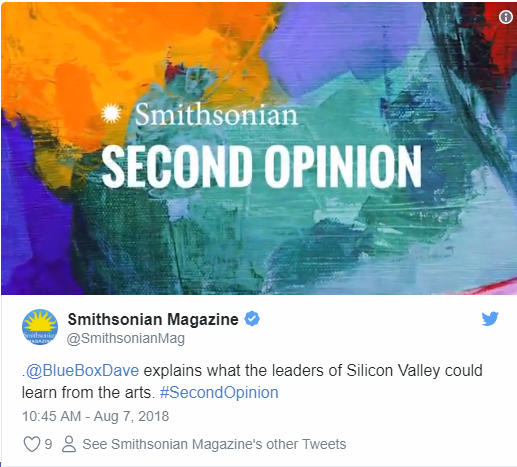
The Federalist’s David Marcus recently took part in a panel discussion led by the secretary of the Smithsonian, David Skorton. The event was part of the Smithsonian’s Second Opinion program, a quarterly online digital platform that explores current public questions.
On the panel Marcus was joined by Rebecca Rabinow, director of the Menil Collection in Houston, Texas; Peter Schjeldahl, the long-time senior art critic at The New Yorker; and Maria Magdalena Campos-Pons, a critically acclaimed artist and professor of studio art at Vanderbilt University.
The wide-ranging, hour-long discussion deals with questions about the potential for political neutrality in arts institutions, what role the government should play in funding the arts, what the state of arts is today, and how the arts can be useful in an increasingly tech-heavy world. Marcus addresses that here: Read more from the Federalist.
Smithsonian reissues classic Lightnin’ Hopkins LP
Houston Chronicle, August 7
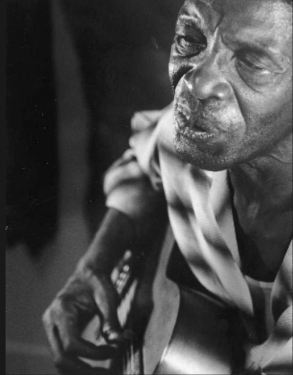
Blues artist Sam ‘Lightnin’ Hopkins. Houston Chronicle photo from 1963
Lightnin’ Hopkins’ self-titled 1959 album will return to print on vinyl for the first time in years thanks to a new Smithsonian Folkways program that will recirculate some of the most storied titles from its vast archives.
Smithsonian Folkways is celebrating its 70th anniversary this year. The label was founded in 1948 by Moses Asch, a sound engineer from Poland who believed strongly in documenting music and culture. The Folkways statement on his vision: “Our mission is the legacy of Moses Asch, who founded Folkways Records in 1948 to document ‘people’s music,’ spoken word, instruction, and sounds from around the world.” Read more from Andrew Dansby for the Houston Chronicle.
Pushing the Envelope: Mail Art from the Archives of American Art
Blouin ArtInfo, August 9
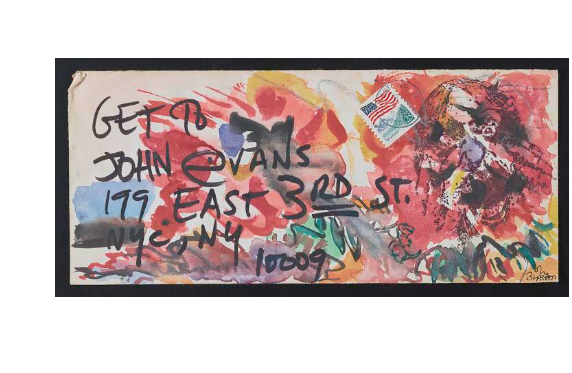
“Blaster Al Ackerman mail art to John Evans,” circa 1988 by Ackerman, Blaster Al, 1939-2013
(Courtesy: Archives of American Art)
The Archives of American Art, Smithsonian Institution, (the Archives) is featuring a new exhibition from its expansive collections documenting the international mail art movement. “Pushing the Envelope: Mail Art from the Archives of American Art” features postcards, letters, and packages that tested the limits of what could be posted.
Beginning in the 1960s, artists from around the world looked to the postal system as an alternative means of producing, distributing, and receiving art. Mail art (alternatively called “correspondence art” or “postal art”) emerged as a form of artistic practice in which an international network of participants use the mail to make art and share it with others.
“With letters, postcards, and packages — as well as material that tested the limits of what could be posted — mail artists circumvent traditional elite modes of display and distribution (such as museums and commercial galleries) in favor of the more accessible space of the modern post,” the museum says. Read more from Blouin ArtInfo.
A new lust for elephant skin jewelry could decimate Myanmar’s giants
PBS Newshour, August 8
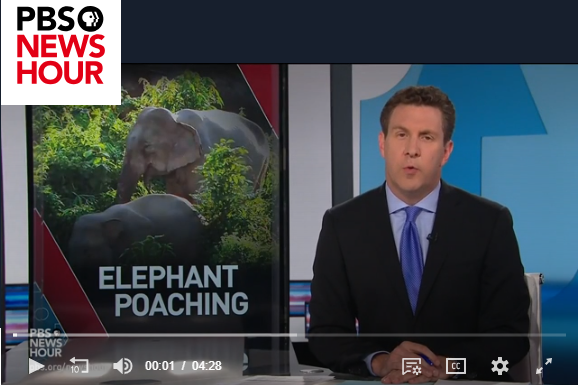
The poaching of African elephants, where they are murdered for their ivory tusks, is well-documented. But halfway around world in Myanmar, their cousins are 10 times more endangered and facing a new serious threat. Poachers are taking the skin of Asian elephants and turning it into ruby red jewelry. The NewsHour’s Nsikan Akpan reports. Read the full transcript from PBS Newshour.
HIRSHHORN MUSEUM ACQUIRES TINO SEHGAL’S THIS YOU, ITS FIRST-EVER PERFORMANCE WORK
ArtForum, August 9

Tino Sehgal (Photo courtesy Tate)
The Hirshhorn Museum and Sculpture Garden announced today that it has acquired its first-ever performance artwork: Tino Sehgal’s This You, the artist’s only outdoor work to date. Debuting Labor Day weekend and running for six weeks, from September 1 to October 14, 2018, the piece will be realized by a group of Washington, DC–based musicians who will foster unique encounters with visitors within the institution’s plaza and sculpture garden.
“For more than a decade the Hirshhorn has demonstrated a unique commitment to the acquisition and presentation of experimental and new media works,” said director Melissa Chiu. “Tino enters the collection at a significant moment, providing fresh insight and further strengthening the museum’s dialogue around contemporary performance.” Read more from ArtForum.
President Polk inaugurates Smithsonian complex, Aug. 10, 1846
Politico, August 10
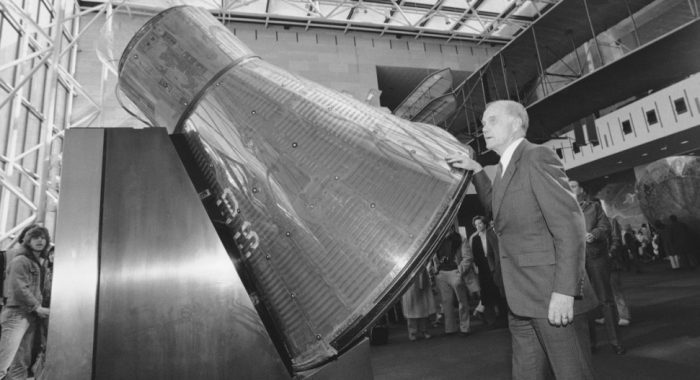
In a visit to the Smithsonian’s Air and Space Museum in February 1982, Sen. John Glenn stands next to the Mercury Spacecraft Friendship 7 in which he had orbited the Earth exactly 20 years before. | J. Scott Applewhite/AP Photo
On this day in 1846, after a decade of often heated debate, Congress passed the Smithsonian Institution Act. It was signed into law by President James K. Polk. An independent federal trust, the Smithsonian has become the world’s largest museum, education and research complex.
The Smithsonian operates as a public-private partnership. It currently consists of 19 museums (11 of them on the National Mall), 21 libraries, the National Zoo, and numerous education and research centers, including the Smithsonian Astrophysics Observatory, Smithsonian Tropical Research Institute, Smithsonian Environmental Research Center and Smithsonian Science Education Center. Read more from Andrew Glass for Politico.
This Solar Probe is Built to Survive a Brush With the Sun
Wired, August 10

BRIAN MONROE/NASA GSFC/CIL
Update: After an initial delay, the Parker Solar Probe successfully launched at 3:31am EST, Sunday August 12th.
Early Saturday morning, the skies above Cape Canaveral will light up with the launch of the Parker Solar Probe. Its mission? To sweep through the sun’s infernal outer atmosphere, studying the gaseous fireball at the center of the solar system at closer range than any man-made object ever before. Read more from Megan Molteni for Wired.
We May Never Understand the Ocean-Wide Damage Done by Industrial Whaling
The New Yorker, August 8
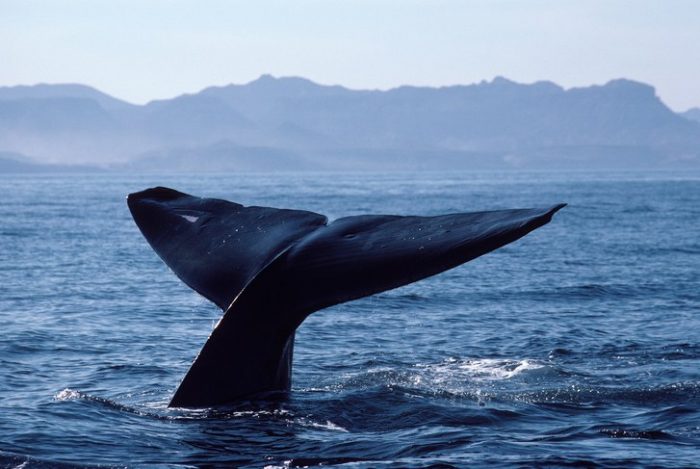
Whales are a powerful oceanographic force in their own right, one that begets even more life; many ecosystems are still straining to equilibrate from the effects of twentieth-century whaling.Photograph by Francois Gohier / VWPics / Redux
few months ago I learned that, as recently as 1972, General Motors was using sperm-whale oil in transmission fluid in its cars. I’m not sure why I was surprised to learn this. It took nearly another decade for much of the world to agree to ban commercial whaling, in 1982. (A handful of countries still ignore the ban.) But the detail about G.M. still struck me as anachronistic. The global pursuit of whales inescapably connotes the romance of nineteenth-century New Bedford and Nantucket: delicately embossed scrimshaw, Melville, oil paintings of stately twilit schooners setting out on the main. Not puke-green Chevy El Caminos.
In his new book, “Spying on Whales,” the Smithsonian paleontologist Nick Pyenson illuminates just how mistaken this popular conception is. He invites the reader to consider the almost satanic landscape of twentieth-century whaling, when it took on the guise of a mechanized, diesel-powered, global killing machine that hit its crescendo after the Second World War. Though whales might represent for humanity “a dream of alien life: approachable, sophisticated and unscrutable,” in Pyenson’s words, that didn’t stop us from killing three million of them last century. The not-so-invisible hand of the free market plucked three hundred and twenty-five thousand blue whales from the Southern Ocean alone, where the animals have all but disappeared; this decades-long death march played out under the supervision of a largely toothless (or perhaps indifferent) International Whaling Commission, which functioned in its early decades “more like an international hunting club” than conservation body, Pyenson writes. Read more from Peter Brannen for The New Yorker.
How the Klansman who shot toward a black man in Charlottesville ended up at the African-American Museum
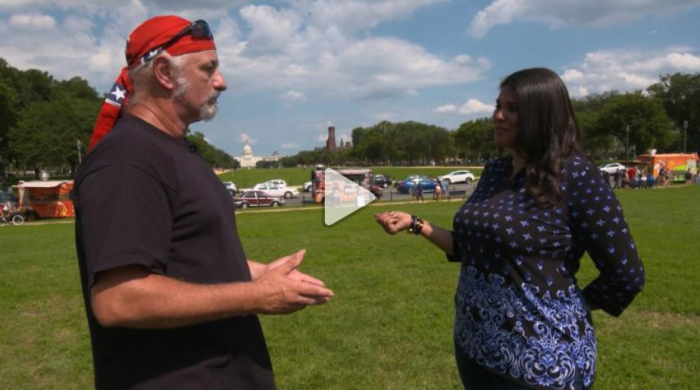
CNN, August 10
Staring at a black man in Charlottesville a year ago, Richard Preston took out his gun and fired. Now he, an imperial wizard of the Ku Klux Klan, is being stared at by a crowd of black people at the National Museum of African American History and Culture.
He walks past a long line of people waiting to pay their respects to murdered teenager Emmett Till.
There is a lone pew. The mood is somber and heavy. Like a never-ending memorial service or wake.
And there is the glass-topped casket, demanded by Till’s mother so everyone could see how her boy had been beaten beyond recognition. Till was killed in Mississippi in 1955 when he was 14 years old by two white men for allegedly whistling at a white woman. His gruesome death further mobilized the civil rights movement. Read more from Mallory Simon for CNN.
Posted: 21 August 2018





